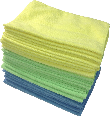Cleaning Oil Off of Tiles
Written by Lee Wyatt (last updated February 14, 2022)
Cleaning tile can often be a difficult task, but when you are faced with the need to clean oil off of tiles it can seem even more so. That being said, cleaning oil off of tiles doesn't need to be as hard or difficult as people make it out to be. There are a few things that you can do which will allow you to begin cleaning off that oil, and leave you with some beautiful tile once again.
- Wipe it all up. Using some rags that you won't mind throwing away. Begin wiping up as much of the oil as you possibly can. Keep the mess confined to as small of an area as possible. When you cannot get anymore oil wiped up with that specific rag, dispose of it, and begin wiping with a new rag. Continue this process until you cannot pickup any more oil from the tiles. When disposing of the rags, be sure that you dispose of them properly. Be aware that some areas may consider these oil encrusted rags to be hazardous materials, and will have specific methods listed for disposing of them.
- Wash with soap. When you begin washing the tiles you cannot use just any type of soap to do it. You will need to use some gentle soap that has been designed to cut through grease and oil in order to begin really getting rid of the oil mess. Some of the best types of soaps that you can use are things like Dr. Bonners, Palmolive, or Dawn. Apply a little bit of the soap to a damp sponge or soft green scrubby, and then begin scrubbing away at the oil mess. Periodically rinse out the scrubby and then reapply the soap. After you have removed as much oil as possible with this method, rinse the area with clean water.
- Wash with specialized cleaners. After the stained area has been rinsed, begin washing again with some specialized cleaners. These should be relatively gentle cleaners that will not damage the tile, but which will remove the remaining stain. Some examples of these cleaners are products like Zap or CLR (Calcium, Lime, and Rust Remover). Apply the cleaner directly to the area as according to the manufacturers directions, and then wash with a soft green scrubby that is slightly damp. Rinse the scrubby out periodically to ensure maximum effectiveness.
- Rinse and repeat. Completely rinse the area, and allow it to air dry. Once it is dry, inspect to see if there is still any stain remaining. If there is you need to repeat the entire process. Continue to repeat the entire process until the stain has been completely removed. At the most, you should only need to do this three times before you have removed all of the stain.
Author Bio
Lee Wyatt
Contributor of numerous Tips.Net articles, Lee Wyatt is quickly becoming a regular "Jack of all trades." He is currently an independent contractor specializing in writing and editing. Contact him today for all of your writing and editing needs! Click here to contact. Learn more about Lee...
Installing a Garbage Disposal
Installing a garbage disposal yourself is a task that almost every homeowner, or do it yourselfer can do. Why spend the ...
Discover More
Pruning Tools
Pruning is an important part of gardening and landscaping, and as such needs to have the proper tools. Without the proper ...
Discover More
Seven Layer Dip
If you are having a get together, or are simply looking for a great dip to go along with your favorite chips, then you ...
Discover More
Cleaning Popcorn Ceilings
According to some, popcorn ceilings are more than a bit out dated. However, just because they aren't very fashionable now ...
Discover More
Cleaning Up After Potted Plants
Potted plants can help soften even the starkest room. Unfortunately, if the proper care and precaution isn't taken, then ...
Discover More
Understanding Upholstery Cleaning Codes
Getting your upholstery clean can often be little difficult for those who have never done it before. One of the best ...
Discover More

Comments